Australia stands out as an attractive market for medical devices due to its mature, well-funded, and stable healthcare system. However, breaking into this market is not without its intricacies and challenges. In this article, we’ll delve into the essential factors and insights for a successful entry into the Australian medical device market in 2024.
Understanding the Australian Healthcare System
Australia boasts a healthcare system that is not only mature but also well-funded and remarkably stable. While it offers a promising landscape for medical device companies, it demands meticulous planning due to its complexities and high barriers to entry. In the context of 2024, comprehending the nuances of the Australian healthcare ecosystem is paramount for a successful Go-To-Market strategy.
Barriers to Entry:
- Complexity: Despite serving a relatively small population, Australia’s healthcare system is intricate. It comprises both public and private hospital systems, each highly regulated and functioning differently under the Medicare umbrella, which can be bewildering for newcomers.
- Government Structure: Adding to the complexity, the Federal and State governments have distinct yet interlinked responsibilities in healthcare administration.
In September 2023, a significant milestone was reached, when a substantial part of the Australian Government’s Prostheses List Reform was enacted. This included changes to the Prostheses List, now known as the Prescribed List (PL), along with a revamped application process and cost recovery for submissions. For in-depth insights into these developments, refer to our recent article: The Prescribed List (formerly Prostheses List) Update – 2023.
If you are contemplating introducing a medical device to the Australian market, the following points merit careful consideration:
• Medicare Coverage: Does the Australian Medicare System fund a medical service (i.e. does a Medicare Benefits Schedule (MBS) item number exist) that aligns with your medical device’s purpose?
• MSAC Application: If not, do you need to apply to the Australian Government’s Medical Services Advisory Committee (MSAC) to seek coverage for a new medical procedure?
• Clinical and Economic Evidence: What evidence is necessary for an MSAC application? What are the associated timelines and costs?
• Outpatient vs. Inpatient Usage: Is your device used in an outpatient or inpatient setting? This distinction has implications for reimbursement.
• Implantability: Is your device implantable? The private sector offers specific reimbursement opportunities beyond other admission costs, governed by the Australian Government’s Prescribed List of Medical Devices (PL).
• Non-Implantable Devices: If the device isn’t implantable, can it still be included on the PL?
• Timelines and Costs: What are the timelines, costs, and clinical and economic evidence requirements for PL inclusion?
• Public Hospital Funding: What funding opportunities exist for your device in the public hospital sector?
The significance of Feasibility Assessment
One common pitfall for companies entering the Australian market is inadequate preparation and unrealistic expectations. Especially for innovative technologies, feasibility assessments prove invaluable. We strongly advocate commissioning a feasibility assessment before commencing the application process, particularly for groundbreaking technology.
What can you expect from a Feasibility Assessment?
• Reimbursement Pathways: A feasibility assessment outlines the available pathways for reimbursement for your medical device in Australia, including timelines and costs.
• Realistic Assessment: It provides a realistic assessment of available clinical evidence and the proposed device price.
At Commercial Eyes, our Access, Research & Intelligence (ARI) team specialises in conducting feasibility assessments for clients venturing into the Australian market. Our experience has consistently shown that clients often adjust their plans based on a thorough understanding of the landscape. Some opt to delay applications, conserving resources while awaiting additional evidence or meeting specific requirements.
Entering the Australian medical device market necessitates meticulous planning and a nuanced understanding of the intricate healthcare system. An informed approach, supported by a thorough feasibility assessment, can not only save valuable resources but also pave the way for successful market access. The Access, Research & Intelligence (ARI) team at Commercial Eyes is committed to assisting companies in navigating this journey, ensuring a strategic and well-informed entry into the Australian market.

